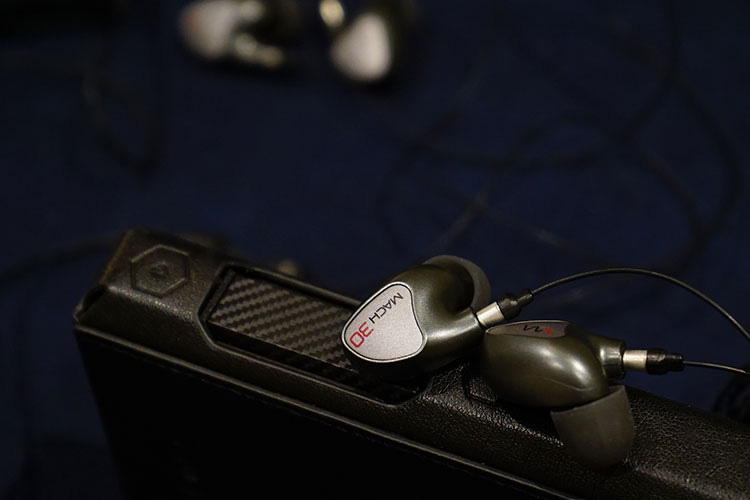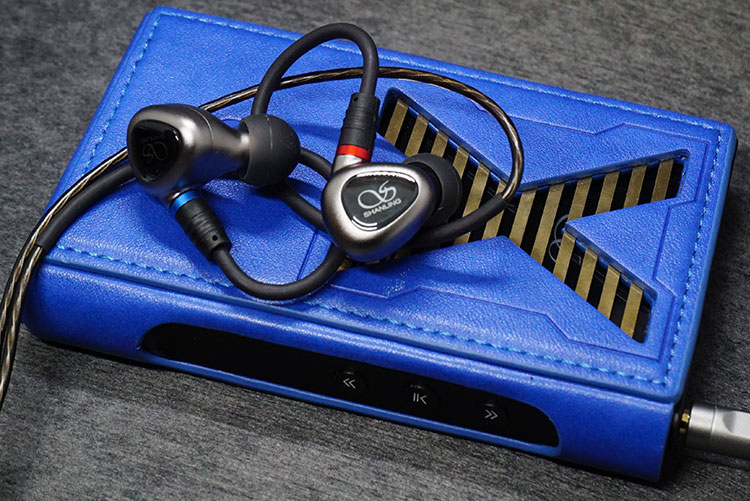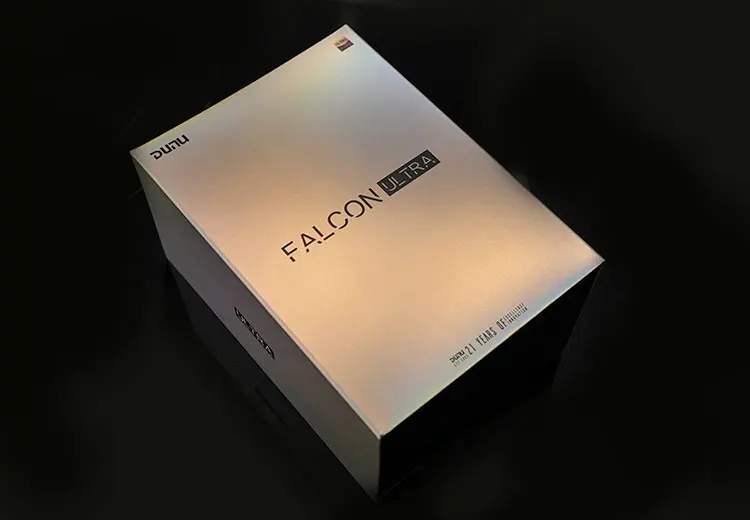Synergy
Efficiency
Rated at 16Ω in impedance and 108dB @1kHz sensitivity, the Falcon Ultra is quite sensitive to power as its specs suggest, and can be driven easily on laptops and mid-tier DAPs.
On a higher gain, the Falcon Ultra can pick out the background hisses quite easily and is quieter with DAPs that have better noise control, which could give a completely dark background.
Pairings
The Falcon Ultra leans towards a slightly bass-light tuning when powered by less powerful sources, resulting in a more treble-leaned and detailed overall signature.
Therefore, to achieve a more immersive experience with enhanced bass impact, it can be paired with sources that have a more intense and rich bass tuning.
When paired with the HiBy R6 Pro II, the Falcon Ultra delivers a well-balanced and sufficiently extended soundstage. The treble region is particularly noteworthy, with plenty of detail that enhances overall clarity.
On the Shanling M7, it colors the vocal richer, which is preferred with the stainless filter. Contrastingly you will need a more controlled, textured source for pairing with the brass filter.
I tried pairing the Falcon Ultra with old Sony CD players and it gives an airy, engaging low-fi vibes in its output. It may not be the most natural IEM but the boosted frequencies do help extract more details and strengthen the dynamics for some older tunes and aged gears.
For DAPs that boost the treble transients such as the Lotoo Paw Gold Touch, it sounds quite sharp with the Falcon Ultra, slightly too clinical for my own preference but may please those who are seeking a more exciting signature.
It is also noteworthy that this IEM holds on to its character well even when powered by higher-end sources such as the Shanling M9 Plus.
When there is more power and speed from the source, the Falcon Ultra will sound punchier and more responsive in the bass, though the treble elevation and the way it is rolled off for sweetness are still very prominent.
Select Comparisons
Drop + Etymotic ERX
Technical
The ERX is a single-DD, stainless steel housed design made from metal powder and resin, and it utilizes the Estron T2 connector system. Rated 45Ω in impedance and 98 dB @1kHz in sensitivity, rather insensitive to power compared to the Falcon Ultra.
Design
The ERX has a sleek profile and the insertion depth is obviously deeper compared to the glossier-looking Falcon Ultra.
Another major difference is the cable system on the Falcon Ultra that allows switching between 3.5mm and 4.4mm while the ERX is fixed to 3.5mm, this gives the Falcon Ultra a good advantage when powered by a balanced source which is usually more powerful with better separation.
Performance
Comparing both IEMs on a 3.5mm connection, the ERX needs more power and higher gain to sound as dynamic as the Falcon Ultra. Both IEMs have a slightly bass-light response and the ERX exhibits swifter articulation, with the vocal presented comparatively more laid back and less full-bodied.
The Falcon Ultra stages the vocal more upfront and has more prominent treble transients that give it a stronger sense of resolution.
This allows for stronger dynamics and considerably more excitement with different music genres, while the ERX is softer and more relaxing for prolonged listening sessions, and the milder tuning allows it to be paired with more powerful gears and to withstand higher gain without sounding harsh.
Westone Audio MACH 30
Technical
The Westone Audio MACH 30 is rated at 91Ω @1kHz and 110dB @1kHz in sensitivity. From its name, it is easy to deduce that this is a multi-driver IEM with 3 balanced armatures fitted inside, with each of them handling the lows, mids, and treble respectively.
The MACH 30 uses a T2 connector system and comes with Linum Estron SuperBaX stock cables that are extremely light.
Design
The MACH 30 looks very future-proofed and is very sleek in design, more so compared to the fancier-looking Falcon Ultra which is already quite slim in size and is not too protruding out of the ears.
While the faceplate is metallic, the MACH 30 employs a polycarbonate body and is matched with an extremely lightweight cable.
The Falcon Ultra is comparably more flashy and robustly built, with a more functional cable that allows the user to switch between 3.5 and 4.4mm cables. With the MACH 30 only a 3.5mm option is offered, which is more limiting as DAPs nowadays are balanced output optimized.
Performance
Testing both IEMS on the FiiO M11S, the bass quantity is fuller on the MACH 30 compared to the Falcon Ultra on stainless steel nozzle, which punches lighter and faster. Such favors replaying male vocals with good authority.
The Falcon Ultra sounds cleaner with its stronger treble focus and transients, with the brass nozzle the Falcon Ultra comes closer in sound signature by elevating the mid-bass, though the MACH 30 sounds denser in the bass and renders the vocal body more upfront.
It is quite audible that the MACH 30 takes more power to sound as firm and fast as the more easily powered Falcon Ultra, which makes sense as the MACH 30 is developed for prosumers.
When setting to higher gain, the MACH 30 sounds more natural and firmer in the two ends while the Falcon Ultra gets more exciting, though less controlled.
With strong decoders like the RME ADI-2 Pro which has excellent control and resolution, the Falcon Ultra delivers decent resolution and control in the output, and I am surprised by how well it matches with small dongles.
The MACH 30 is more source dependent, and with 3.5mm connectors, it will take a DAP of higher output to achieve the same level of dynamics.
Shanling ME80
Technical
The Shanling ME80 is equipped with a single 10mm dynamic driver with dual magnet construction and PU + PEEK nano-composite diaphragm, which aims at enhancing efficiency and transient response.
It is rated at 16ohm @1kHz and 111dB @1kHz in sensitivity, which suggests that it is marginally more sensitive than the Falcon Ultra.
Design
The ME80 is CNC machined from 6000 series aluminum alloy, topped with a glass insert on its pebble-like body that is sand-blasted to look quite premium.
The ME80 is very well built for its price and is 3.5mm terminated to fit entry-level players. While the body unit is very well built on the ME80, I like how subtle the logos are placed on the Falcon Ultra, which also has a more premium-looking cable.
Performance
The ME80 has a closer sensitivity rating to the Falcon Ultra than the other two IEMs compared and it is tuned in quite a similar way, where the treble transients are emphasized and the mid-range articulates smoothly.
Both IEMs sound as loud on my laptop though the Falcon Ultra can extract more details easily with a sharper boost in the upper end, resulting in stronger dynamic and a more distinct level of depth, as well as clearer instrument positioning.
One key difference between the ME80 and the Falcon Ultra is their performance at higher volumes. The Falcon Ultra maintains a higher level of resolution and remains free of distortion.
With the brass filter, the Falcon Ultra also sounds fuller and more effortless when more bass kicks in, while the ME80 is shyer and not as punchy.
Although the ME80 shares a similar treble focus with the Falcon Ultra, it does not offer the same level of definitive power, especially in the upper half of the audible spectrum, which becomes more noticeable with weaker sources.
Additionally, the Falcon Ultra’s 4.4mm connectivity allows it to be powered by balanced outputs on dongles, which can further strengthen its dynamics.
Our Verdict
With a robust yet attractive design and thoughtful tuning, the Falcon Ultra is a great choice for audiophiles seeking higher clarity as well as versatility on the go, all at an affordable price point.
The strong magnets implemented help deliver a remarkably dense and textured output, so you probably need to keep it away from mechanical watches.
The rest of the package is enjoyable and I could easily recommend it to those who are using the IEMs for different purposes and are seeking an exciting, well-defined yet controlled sound signature.
DUNU Falcon Ultra Technical Specifications
- Impedance: 16Ω @ 1kHz
- Sensitivity: 108dB±1dB @ 1kHz
- Frequency Response: 5Hz-40kHz
- THD+N: <0.3% at 1kHz
- Cable Material: 4-Core Silver-Plated Copper Litz
- Connector Type: Patented MMCX Connectors
- Termination: 3.5mm TRS and 4.4mm TRRS
- Weight: 10g / side







